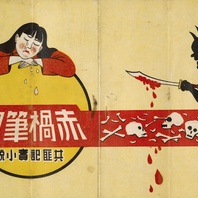
Item
Chihuo biji: Gongfei jishi xiaoshuo(A record of the Red Peril: A novel recording the deeds of the Communist bandits)
This book, almost certainly produced by the Japanese military, tells the story of communist violence against Chinese peasants in wartime Shanxi, and the escape of an anti-communist Chinese peasant girl to occupied Beijing. It was clearly written to discourage civilian support for the communist resistance in north China, and to foster peasant support for the newly-established PGROC early in the occupation. The weeping peasant woman is juxtaposed to the sinister “devil” that is international communism.
Read More
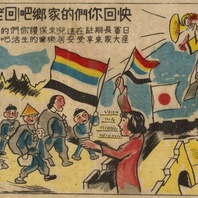
Item
Kuai hui nimen de jiaxiang ba! (Hurry back to your homes!)
This leaflet, produced with the aim of encouraging civilians in occupied north China to return to cities and towns under Japanese rule, includes many of the standard tropes of early occupied north China propaganda: a “new woman”; city walls; the “five-coloured flag” (wuseqi). The text on the leaflet reads: “Hurry back to your homes! Return to your hometowns! The Japanese army will be here for a long time. Come and protect your livelihoods and your assets. Everyone can savour living in peace and enjoying their work again”.
Read More
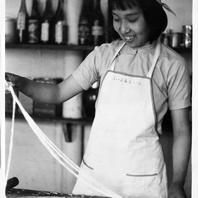
Item
Noodle cooking
From a collection of staged photographs produced under the title “Life at a Girls School in Peking”, and produced at the Peking Jiyu Gakuen in Japanese-occupied Beijing. The original caption reads: “A girl is pulling noodles according to a Chinese style instead of cutting smaller [sic]”.
Read More
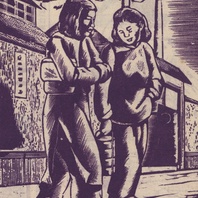
Item
Shang gong (Off to work)
This woodcut, by an artist called Gu Yihua, was reproduced in Zhonghua huabao (Chinese Pictorial) 1.4 (November 1943). The importance of the muke (woodcut) form to artistic practice in occupied China has been almost entirely overlooked in the literature. The muke form has hitherto been almost exclusively associated with the art of resistance in China, despite being an important part of “occupation” visual cultures throughout the war.
Read More
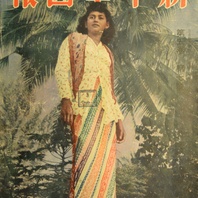
Item
Xin Zhonghua huabao (New China Pictorial) cover, July 1943
This cover image from the Xin Zhonghua huabao (New China Pictorial) 5.7 (July 1943) shows a colourised photograph of an unnamed woman, probably from Malaya. The New China Pictorial was a bilingual (Chinese-English) magazine published from 1939 through 1944 in Shanghai by the occupation journalist Wu Linzhi for distribution in China and throughout Southeast Asia. This magazine employed cover images of women from areas of Southeast Asia that had been conquered by Japan with increasing regularity over the course of 1943 and 1944, having previously focused on Chinese film celebrities.
Read More
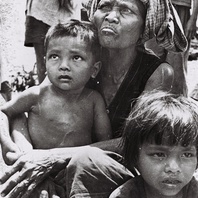
Featured Item
A woman and children (survivors), Cambodia
This photograph is part of the collection held by the Agence Khmère de Presse (AKP) and Cambodia’s Ministry of Information. This collection, which documents the early years of the People’s Republic of Kampuchea as photographed by the Vietnamese and a small team of Cambodian photographers, has not yet been classified or indexed.
Read More
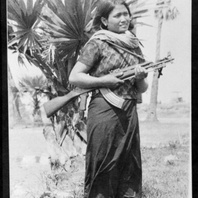
Featured Item
Female soldier of the Kampuchea United Front for National Salvation
This unattributed photograph shows a young Cambodian female soldier of the Kampuchea United Front for National Salvation (KUFNS, also known as FUNSK) [Front or Renakse]. She stands in front of a tree holding a rifle. She is not in uniform but wears a sarong (traditional lower garment). The image was featured in the publication (French and English versions) entitled The People’s Republic of Kampuchea (1979). This photograph is part of the collection held by the Agence Khmère de Presse (AKP) and Cambodia’s Ministry of Information. This collection, which documents the early years of the People’s Republic of Kampuchea as photographed by the Vietnamese and a small team of Cambodian photographers, has not yet been classified or indexed.